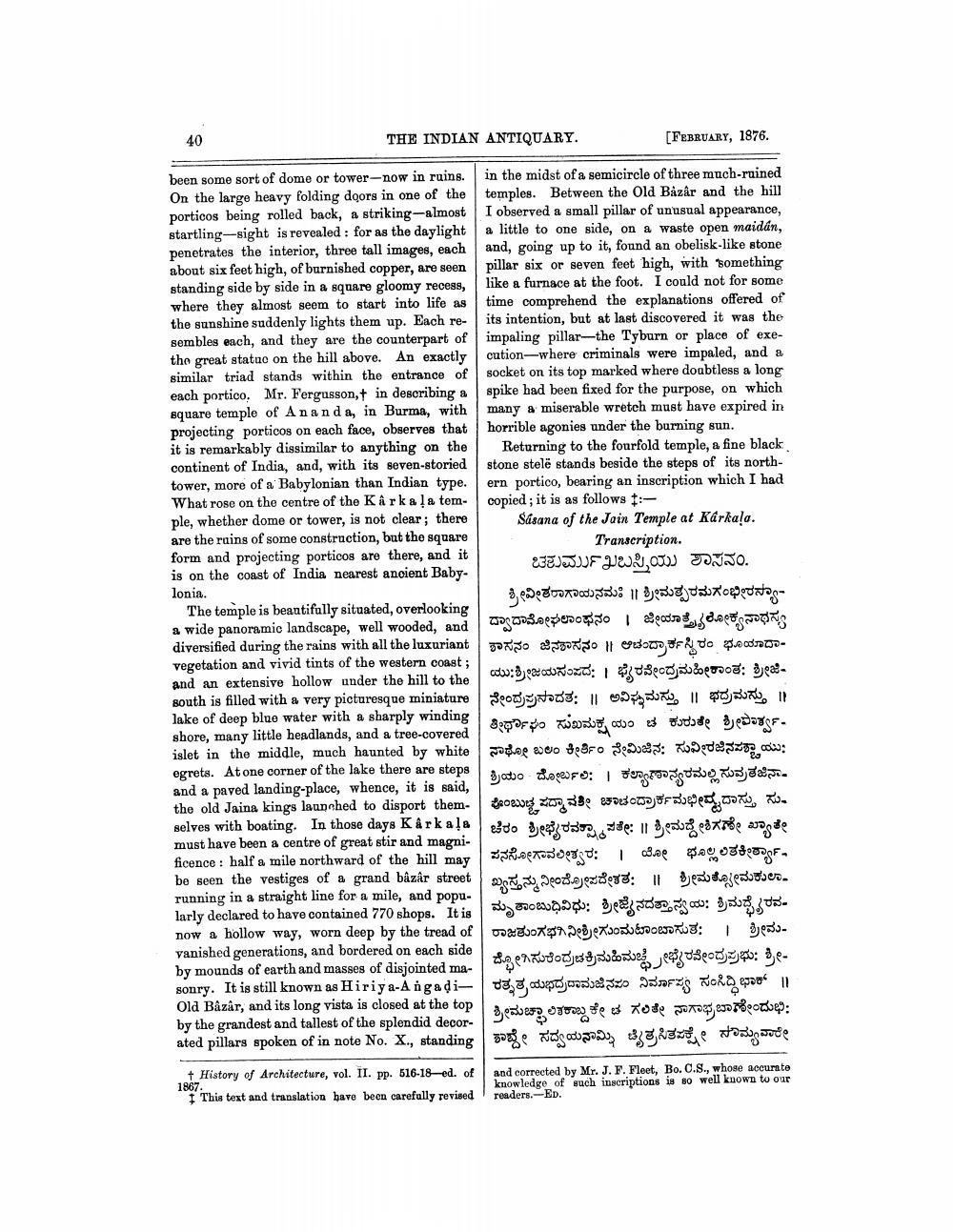________________
40
THE INDIAN ANTIQUARY.
[FEBRUARY, 1876,
been some sort of dome or tower-now in ruins. in the midst of a semicircle of three much-ruined On the large heavy folding doors in one of the temples. Between the Old Bazar and the hill porticos being rolled back, a striking-almost I observed a small pillar of unusual appearance, startling-sight is revealed : for as the daylight a little to one side, on a waste open maidán, penetrates the interior, three tall images, each and, going up to it, found an obelisk-like stone about six feet high, of burnished copper, are seen pillar six or seven feet high, with something standing side by side in a square gloomy recess, like a furnace at the foot. I could not for some where they almost seem to start into life as time comprehend the explanations offered of the sunshine suddenly lights them up. Each re- its intention, but at last discovered it was the sembles each, and they are the counterpart of impaling pillar-the Tyburn or place of exethe great statue on the hill above. An exactly cution-where criminals were impaled, and a similar triad stands within the entrance of socket on its top marked where doubtless a long each portico. Mr. Fergusson,t in describing a spike bad been fixed for the purpose, on which square temple of Ananda, in Burma, with many a miserable wretch must have expired in projecting porticos on each face, observes that horrible agonies under the burning sun. it is remarkably dissimilar to anything on the Returning to the fourfold temple, a fine black continent of India, and, with its seven-storied stone stelë stands beside the steps of its northtower, more of a Babylonian than Indian type. ern portico, bearing an inscription which I had What rose on the centre of the Karkala tem- copied; it is as follows :ple, whether dome or tower, is not clear; there Sásana of the Jain Temple at Karkala. are the rains of some construction, but the square
Transcription. form and projecting porticos are there, and it is on the coast of India nearest ancient Baby
ಚತುರ್ಮುಖಬಸಿಯು ಶಾಸನಂ. lonia,
ಶ್ರೀವೀತರಾಗಾಯನಮಃ || ಶ್ರೀಮತ್ಪರಮಗಂಭೀರನ್ಯಾThe temple is beautifully situated, overlooking a wide panoramic landscape, well wooded, and | ದ್ವಾದಾಮೊಘಲಾಂಭನಂ | ಜಿಯಾಲೋಕನಾಥಸ್ಯ diversified during the rains with all the luxuriant | ಶಾಸನಂ ಜಿನಶಾಸನಂ | ಆಚಂದ್ರಾರ್ಕಬ್ಬರಂ ಭೂಯಾದಾvegetation and vivid tints of the western coast; and an extensive hollow under the hill to the
ಯು:ಶ್ರೀಜಯಸಂಪದ: | ಭೈರವೇಂದ್ರಮಹೀಕಾಂತ: ಶ್ರೀಜಿsouth is filled with a very picturesque miniature ನೇಂದ್ರಪ್ರಸಾದತಃ || ಅವಿಭಮಸ್ತು || ಭದ್ರಮಸ್ತು || lake of deep blue water with a sharply winding shore, many little headlands, and a tree-covered
ತಿರ್ಥ್ಯಘಂ ಸುಖಮಕ್ಷಯಂ ಚ ಕುರುತೇ ಶ್ರೀವಾರ್ತ್ಸislet in the middle, much haunted by white ನಾಥೋ ಬ೦೦ ಕೀರ್ತಿ೦ ನೇಮಿಜಿನ: ಸುವಿರಜಿನಪತ್ಥಾಯು; egrets. At one corner of the lake there are steps
ಶಿಯಂ ದೊರ್ಬಲಿ: | ಕಲ್ಯಾಣಾನ್ಯರಮಲ್ಲಿ ಸುವ್ರತಜಿನಾ. and a paved landing-place, whence, it is said, the old Jaina kings launched to disport them. ಪೊಂಬುಳ್ಳ ಪದ್ಮಾವತಿ ಚಾಚಂದ್ರಾರ್ಕಮಭೀಷ್ಟದಾಸ್ತು ಸು. selves with boating. In those days Karkala
ಜೆರಂ ಶ್ರೀಭೈರವಕ್ಷಾಪತೇ || ಶ್ರೀಮದ್ದೆಶಿಗಣೆ ಖ್ಯಾತ must have been a centre of great stir and magnificence: half a mile northward of the hill may ಸನಸೋಗಾವಲೀಶ್ವರ: | ಲೋ ಭೂಲತಕಿರ್ಶ್ಯಾ • be seen the vestiges of a grand bazar street
ಖ್ಯಸ್ತನ್ನು ನೀಂದ್ರೋಪದೇಶತ: || ಶ್ರೀಮತ್ತೋಮಕುಲಾrunning in a straight line for a mile, and popularly declared to have contained 770 shops. It is
ಮತಾಂಬುಧಿವಿಧು: ಶೀನದತ್ತಾಯ; ಶ್ರೀಮದ್ಭರವnow a hollow way, worn deep by the tread of | ರಾಜತುಂಗಭಗಿನಿ ಗುಂಮಟಾಂಬಾಸುತ: | ಶ್ರೀಮvanished generations, and bordered on each side by mounds of earth and masses of disjointed ma
ದೌಗಿಸುರೆಂದ್ರಚಕ್ರಿಮಹಿಮಜ್ಞೆ ಭೈರವೇಂದ್ರಪ್ರಭು: ಶ್ರೀsonry. It is still known as Hiriya-Angadi- | ರತ್ನತ್ರಯಭದ್ರದಾಮಜಿನಸು ನಿರ್ಮಾಸ್ಯ ಸಂಸಿದ್ದಿಭಾಕ್ || Old Bâzâr, and its long vista is closed at the top by the grandest and tallest of the splendid decor
| ಶ್ರೀಮಚ್ಛಾಲಿತಕಾಬ್ದ ಕೇ ಚ ಕಲಿತೇ ನಾಗಾಭ್ಯಬಾಂದುಳಿ: ated pillars spoken of in note No. X., standing | ತಾಜ್ಜೆ ಸದ್ವಯನಾಮ್ಮಿ ಚೈತ್ರಸಿತಪಕ್ಷೇ ಸೌಮ್ಯವಾಗೇ
† History of Architecture, vol. II. pp. 516-18-ed. of 1867.
This text and translation have been carefully revised
and corrected by Mr. J. F. Fleet, Bo. O.S., whose accurate knowledge of such inscriptions is so well known to our readers.-E




